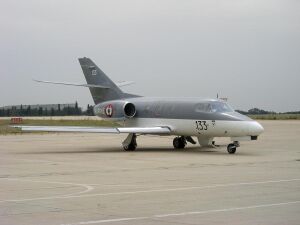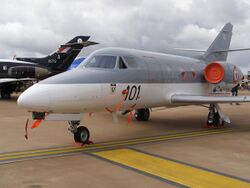Engineering:Dassault Falcon 10
| Falcon 10 (Mystère 10) | |
|---|---|

| |
| Role | Business jet |
| National origin | France |
| Manufacturer | Dassault Aviation |
| First flight | 1 December 1970 |
| Introduction | 1971 |
| Status | Active service |
| Primary user | Corporate owners |
| Produced | 1970–1989 |
| Number built | 226 |
| Developed from | Dassault Falcon 20 |
The Dassault Mystère/Falcon 10 is an early corporate jet aircraft developed by French aircraft manufacturer Dassault Aviation. Despite its numbering sequence it was actually developed after the Falcon 20, and although it is sometimes considered as a scaled-down version of that aircraft, it was totally redesigned with a non-circular fuselage, a new wing with slotted flaps, a split passenger door and many simplified circuits compared to the Falcon 20.[1]
Production began in 1971 and ceased in 1989, but it remains a popular business jet on the second hand market.
By 2018, Falcon 10s from the 1970s were priced at $300,000 to $600,000.[2]
Variants
- Minifalcon
- This was the original name of the Dassault Falcon 10.
- Falcon 10
- Executive transport aircraft.
- Falcon 10MER
- Seven aircraft used by the French Navy as instrument trainers, VIP transports, and communications and liaison aircraft. MER stood for ‘Marine Entraînement Radar – Navy Radar Training’.
- Falcon 100
- Designed to replace the Falcon 10, the Series 100 had an increased takeoff weight, larger luggage compartment, and glass cockpit.
Operators
Civil operators
 Canada
Canada
- Air Nunavut[3]
 Croatia
Croatia
- Government of Croatia – Former operator.
Military operators
 France
France
- French Navy - received seven Falcon 10 MER aircraft,[4] of which six remain operational with Escadrille 57S as instrument trainers, VIP transports and liaison aircraft as of December 2020.[5]
 Morocco
Morocco
Specifications
Data from Jane's All the World's Aircraft 1980–81[6]
General characteristics
- Crew: 2
- Capacity: 4–7
- Length: 13.85 m (45 ft 5 in)
- Wingspan: 13.08 m (42 ft 11 in)
- Height: 4.61 m (15 ft 1 in)
- Wing area: 24.1 m2 (259 sq ft)
- Aspect ratio: 7.1:1
- Empty weight: 4,880 kg (10,759 lb)
- Max takeoff weight: 8,500 kg (18,739 lb)
- Fuel capacity: 3,340 L (730 imp gal; 880 US gal)
- Powerplant: 2 × Garrett TFE731-2 turbofans, 14.4 kN (3,230 lbf) thrust each
Performance
- Cruise speed: 915 km/h (569 mph, 494 kn) (max cruise)
- Never exceed speed: 650 km/h (400 mph, 350 kn) at sea level;
- Max Mach Number: 0.87
- Range: 3,555 km (2,209 mi, 1,920 nmi)
See also
Related development
Aircraft of comparable role, configuration and era
Related lists
References
- ↑ Donald 1997, p. 305
- ↑ Mark Huber (December 2018). "For many models, market hitting the apex". Aviation International News: 20–21, 24. https://www.ainonline.com/sites/default/files/full-issues/ain_1218.pdf. Retrieved 2018-12-27.
- ↑ Transport Canada listing of aircraft owned by "Air Nunavut" (enter Air Nunavut in the box titled "Owner Name")
- ↑ Donald & Lake 1996, p. 123
- ↑ Lert 2020, pp. 38, 40
- ↑ Taylor 1980, pp. 65–66
- Donald, David; Lake, Jon, eds (1996). Encyclopedia of World Military Aircraft (Single volume ed.). London: Aerospace Publishing. ISBN 1-874023-95-6.
- Donald, David, ed (1997). The Encyclopedia of World Aircraft. Prospero Books. ISBN 1-85605-375-X.
- Lert, Frédéric (December 2020). "Old dogs new tricks". Air International 99 (6): 36–41. ISSN 0306-5634.
- Taylor, John W. R., ed (1980). Jane's All The World's Aircraft 1980–81. London: Jane's Publishing. ISBN 0-7106-0705-9.
- Details on Airliners.net
External links
 |



